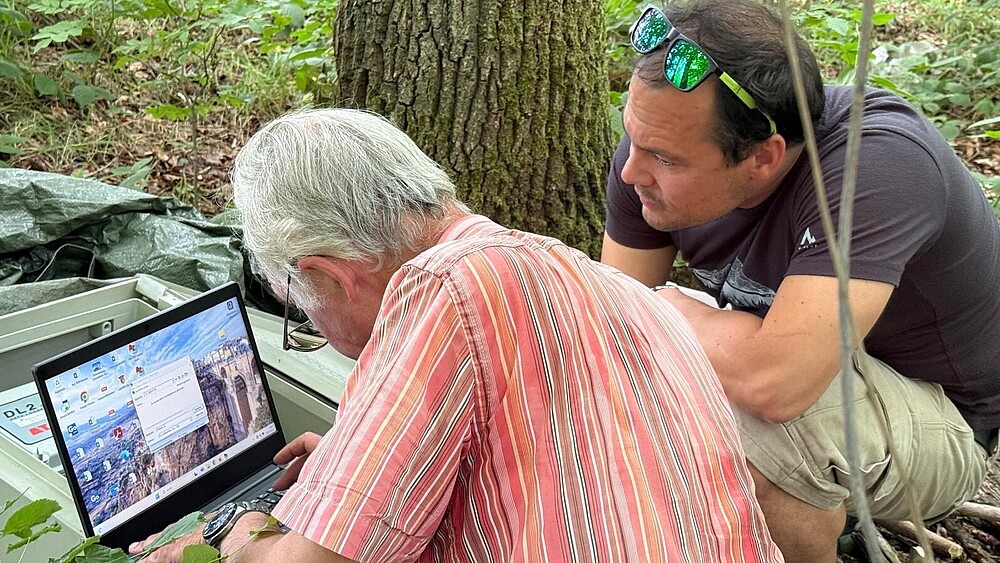HSZG researchers led by Prof. Oliver Wiche are investigating the water balance of trees in order to record the influence of climate change.

Extreme drought and record temperatures will characterize the spring of 2025 - with noticeable consequences for forests across Europe. An international research project is investigating how trees react to the lack of water. Involved: Zittau/Görlitz University of Applied Sciences. A team led by Prof. Oliver Wiche is operating its own measuring field in Saxony to record the influence of climate change on the water balance of soils and trees.
In spring 2025, the German Weather Service (DWD) warned of an ominous development: Germany experienced one of the wettest early years since weather records began in 1881. Between February and mid-April, less than a third of the usual rainfall fell in some places. In some parts of northern and eastern Germany, it was drier than at any time since 1950 - and in Saxony, too, the precipitation deficit was around 35%. In many places, the soil was parched and the topsoil was in an alarming state. The Helmholtz Center for Environmental Research's (UFZ) drought monitor showed values in March 2025 that were even below those of the extreme year 2018 in parts of Germany.
These developments are part of a European trend. The EU climate service Copernicus reported the highest average temperature for a March month in Europe since records began for March 2025. While south-western Europe was affected by unusually heavy rainfall, central Europe lacked any significant amount of precipitation. The spring drought began exceptionally early - with potentially dramatic consequences for forests, agriculture and water supplies.
Experts speak of a dangerous mortgage for the summer: in many places, the soil is already too dry from the winter, groundwater levels are falling, and vegetation and trees come under water stress early in the season. Shallow-rooted species in particular, such as birches or young trees, are the first to show signs of drought stress. The effects on the growth, vitality and long-term stability of forest ecosystems are considerable - and not yet fully understood scientifically.
In view of these developments, the Society for Ecology launched a call to scientific institutions across Europe in May 2025: measurement campaigns on soil water balance and drought stress in trees should be systematically carried out and networked. Within a very short time, a consortium of more than 50 research institutions, including universities, forestry offices, environmental authorities and specialized laboratories, was formed under the leadership of TU Dresden.
One aim of the project is to collect reliable data in various regions and climatic zones in order to record the short-term effects of the drought as well as long-term shifts in the water balance of the forests. Highly sensitive sensor technology and modern isotope analyses are being used.
Zittau/Görlitz University of Applied Sciences is also actively involved in the project. Together with the TU Bergakademie Freiberg, the geoecology working group headed by Prof. Oliver Wiche is operating its own measuring field in a forest near Freiberg. There, TDR probes (Time Domain Reflectometry) and tensiometers continuously record the soil water content and water availability in the root zone of the trees.
In addition, so-called water potentials of the plants are measured - i.e. how hard plants have to "suck" water from the soil. The greater the effort, the higher the water potential and therefore also the potential stress. Leaf samples are also used to analyze physiological parameters, including the concentration of the plant stress hormone abscisic acid and the isotope signature of 13C, which provide indications of changes in photosynthesis under drought stress.
This combination of field measurements and laboratory analysis allows us to reconstruct very precisely how trees deal with a lack of water - and at what point it becomes critical.
”The data obtained is fed into the Europe-wide research network. The aim is to obtain a differentiated picture of how different tree species and forest locations react to increasing drought. Previous drought years (2018-2020) have shown that not only spruce trees, but also many deciduous tree species are coming under increasing pressure.
Targeted strategies can be developed on the basis of such studies - for example, which tree species should be preferred for reforestation in the future, how soils can store water better or where the resilience of the forest can be strengthened through targeted interventions (e.g. deadwood removal, undergrowth management).
Knowledge is also urgently needed at regional level. In Saxony, for example, the water level fell at over 80% of measuring points in 2025 - an alarm signal for forestry, nature conservation and water management alike.
The measuring field near Freiberg is one piece of a larger puzzle: it helps to not only analyze climate impacts retrospectively, but also to observe them in real time. The result is an early warning system for forests based on scientifically sound foundations - an important step towards developing adaptation measures in good time.
With its contribution, the Zittau/Görlitz University of Applied Sciences shows how application-oriented research and European cooperation can go hand in hand - and how important regional universities are for solving global environmental issues.